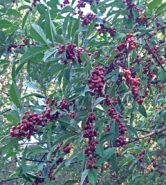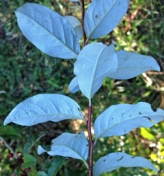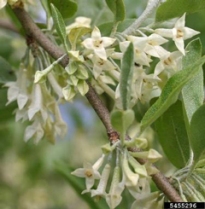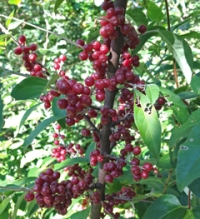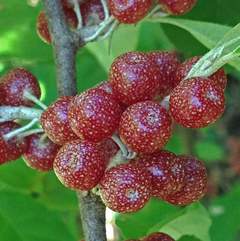This was the title of a question posted on our Discussion Board several weeks ago. Here is the post:
What is the name of the invasive species of small bush/tree with thousands of little red berries, and is spreading like kudzu? It grows two or three inches a day seems like, and is dominating every hedge row in my area. I live near Stuart, Virginia. What is the best way to eradicate them?
My guess was autumn olive but I asked for some additional information to be sure of the identification:
Are the undersides of the leaves silvery in color and are the leaves arranged alternately on the branches? If the leaves are arranged opposite each other on the branches and the leaves are green, then it would be a bush honeysuckle. In either case, they are both invasive and hard to control.
He replied back that the leaves were silvery underneath and they were arranged in an alternate pattern on the stem.
Autumn Olive – as I suspected.
Autumn olive (Elaeagnus umbellata) is a deciduous shrub that is native to China, Japan, and Korea. It was introduced to the United States in 1830 as a fast growing shrub that could be used to quickly revegetate disturbed areas and provide erosion control as well as habitat and food for wildlife. It certainly did the job but unfortunately did it so well that the shrub has now become invasive in much of the eastern and central US.
Autumn olive is very prolific and is as happy growing on dry, rocky, infertile slopes as it is growing in rich garden soil. It is drought tolerant, salt tolerant, and even grows in very acidic soil.
This is one tough plant!
One of the reasons that autumn olive is able to thrive in nutrient-poor soils is its ability to produce its own nitrogen with nitrogen-fixing root nodules. This can become a problem for many of the native species that are adapted to areas with infertile soil because it interferes with the natural nutrient cycle.
In addition, because of its vigorous growth and quick spreading habit, autumn olive can easily outcompete and displace these native plants.
The other problem is that these shrubs produce a tremendous number of small red fruits all along their branches and each of these contains a seed. Birds and other animals apparently scarf up the fruit and are responsible for dispersing the seeds far and wide!
Autumn olive fruit contains a lot of lycopene and is apparently quite tasty when it is perfectly ripe. Before that time, it has a very bitter taste due to high levels of tannin – similar to unripe persimmon fruit. The few that I tried the other day, though deep red in color, really made me pucker up! Definitely not ripe yet! The tannin content decreases as the fruit ripens and it becomes sweeter. If you look online, you can find quite a few recipes which use autumn olive fruit to make jam, juice, and other things!
BUT …
These shrubs ARE invasive and efforts should be made to control them. However, this is no easy task! If you cut them down or burn them, they quickly sprout vigorous new growth from the base. Seedlings pop up everywhere the fruit/seeds drop.
Seedlings can be hand pulled but it is best to do this when the ground is moist so you increase the chances of removing the entire root.
Seedlings and young shrubs can be controlled by spraying the foliage with triclopyr (found in many brush killers) or glyphosate (the active ingredient in Roundup) according to the label directions.
Large, mature shrubs are harder to kill. One of the best methods is to cut them down and then immediately apply an herbicide containing glyphosate or triclopyr directly to the freshly cut stump according to the label directions for stump treatment. You can use a paint brush or a spray bottle to apply the herbicide and if you add a dye to the mix, you can easily see when you have good coverage on the stump.
One of the best times to do this is in the early fall before the fruit (with seeds!) matures. At this time, the plants are beginning to prepare for winter by moving nutrients and stored starches from their leaves into their roots. Spraying systemic herbicides at this time (for any perennial weed) means that these chemicals get transported down to the roots more quickly thereby increasing their efficacy.
Good luck if you have this stuff! It is growing in dense thickets around our little orchard and every year it seems to close in a bit more!

